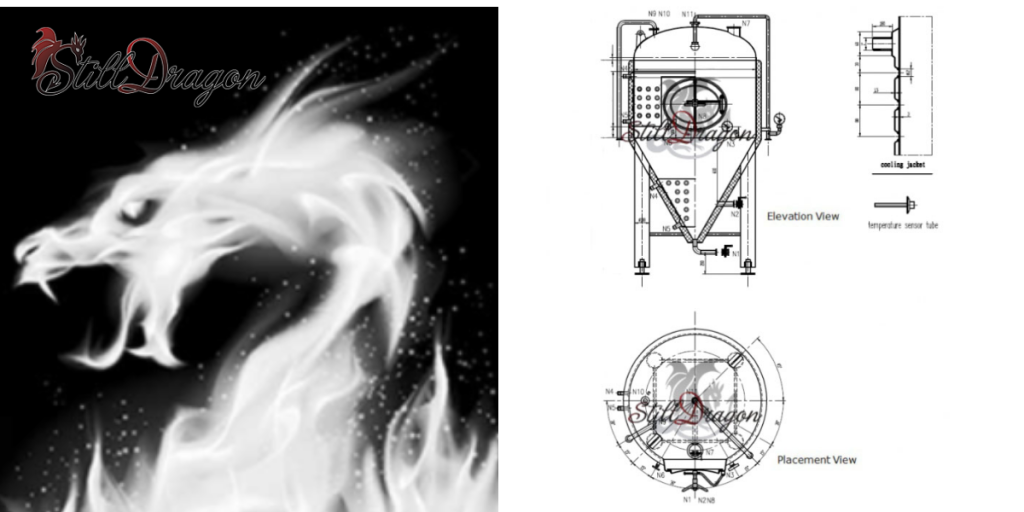How Does a Fermenter Cooling Jacket Work?

It’s all about the yeast. Everything about the business of making alcohol always seems to point back to the yeast. After all, it is the yeast that is responsible for converting our starches into alcohol. Do you fancy venture capital investors seem to think that it is your money that is responsible for making things happen? No. It is the yeast that is in charge. And the better we appreciate their role in this business, the more alcohol they will make for us. Let’s just get that straight right out of the gate.
Ah, I do apologize, I am just reading from the list of demands that the yeast colony has provided me with. They can be temperamental, though they are usually easy to work with as long as their demands are met without resistance.
The Right Temperature: Among Yeast’s Top Demands
Each strain of yeast will have its own preferred working temperature to optimally produce the highest quality yield. For example, Saccharomyces cerevisiae (the most commonly known yeast strain) prefers a working temperature that ranges from 30° C (86° F) to 45° C (113° F). Any hotter or colder, and production rates can be inhibited. So, for the sake of maintaining optimal production times and yields, managing fermentation temperatures is key.
Notwithstanding external influences on fermentation temperatures (a.k.a. the weather), the yeast colony also produces its own heat as it consumes its diet of sugars. Quantities of beer up to about 1000L are likely safe from having to strictly manage fermentation temperatures. Anything larger, however, and the brewer/distiller risks a less than optimal yield, perhaps even provoking the yeast into producing off-putting flavors.
Fermenting in an unconditioned space can allow temperatures to drop so low during the winter months that the fermentation can stall or severely retard completion. On the other hand, allowing temps to spike during the warmer summer months can retard completion and impart off-flavors. This issue of temperature can mean that spirits produced during the winter months may very well have a completely different profile compared to spirits produced during the summer months. So, the obvious solution to help maintain uniform flavor profiles throughout the year is to keep fermentation temperatures as consistently as stable as possible.
How do we do that you ask? Glad you asked. We’ll do that with a fermentation vessel that has a cooling/heating jacket.
A Cooling Jacket on a Fermenter
The fermentation cooling jacket is an additional skin that wraps around the primary vessel. Essentially, a cooling jacket on a fermenter acts like another tank that wraps around what will become the internal wall of the fermentation vessel. There are inlet ports and outlet ports that allow for a cooling medium to be circulated through the jacket. Typically, the flow rate of the cooling medium can be used to control the temperature of the fermentation. The jacket, simply put, is a heat exchanger that transfers heat between two fluids. One fluid being our cooling medium and the other being our fermenting beer or wine.
Could we use a large immersion coil to circulate our cooling medium? Yes, but the downside would be that we could have to increase the flow rates of our cooling medium or reduce the temperature of our cooling medium to be as efficient as the much-larger surface area that the cooling jacket provides. Additionally, cleaning the cooling coil could amount to an unnecessary addition of labor-hours needed to clean and sanitize our fermentation tank. As mentioned in previous blog posts, at the end of the year (or two or three), labor hours will almost without exception cost more than the actual equipment that is specifically designed to reduce the very same labor hours. Getting the right equipment for the job makes the workplace safer, more productive, and ultimately reduces operating costs of your distillery.
Some fermenters are designed for grain in solids fermentation and others are designed in the more traditional conical shape often seen in breweries. In both designs, having the cooling jacket will help to ensure that the fermentation finishes to completion, minimizes off-flavors associated with stressed yeast, and reduces labor hours needed to clean and sanitize the vessel.
Give us a call here at the office to help you work through your fermentation challenges and get your production goals pointed in the right direction.